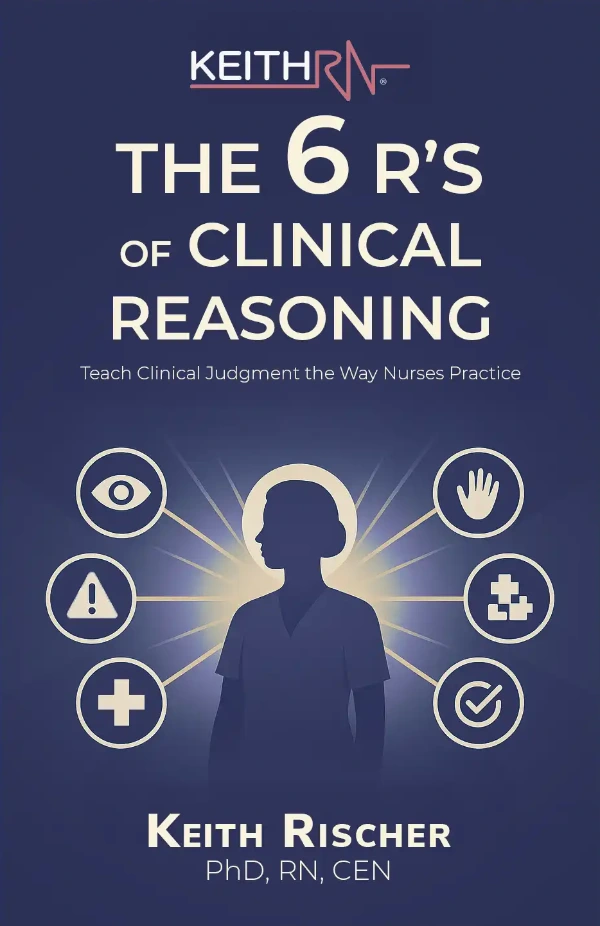
Nursing has struggled with its identity and has worked hard in the past to distinguish itself from physician practice.
NANDA nursing diagnostic statements are an example of this legacy. One of the driving forces to establish nursing “diagnosis” statements was to create a language and taxonomy unique to nursing so nurses could “diagnose” specific patient problems or problems patients were at risk to develop and distinguish itself from physician practice.
But a lot has changed since the 1980’s…no more big hair, mullets, and Zoobaz pants. Though nursing continues to have its unique scope of addressing patient response to illness and disease, there is much that nursing can learn from the medical model as we partner together in caring for patients.
It is essential for the nurse to also have a strong understanding of the applied sciences that are also relevant to medicine in order to be a better nurse.
This includes the need for nurses to have a basic understanding of physician treatment and interventions with an emphasis of the rationale, understand the medical approach to illness and current research on treatments, and a deep knowledge of the applied sciences that include anatomy and physiology as well as pathophysiology.
If a nurse understands the essence of physician practice and WHY specific medications and treatments are used to treat illness, the nurse’s practice will improve by seeing and understanding the big picture of both domains of practice. This will develop needed critical thinking so the nurse is able to USE and APPLY knowledge from BOTH domains of practice.
Understanding the Medical Model
It is imperative that students understand nursing science deeply in order to establish care priorities and recognize the relevance of clinical data. But we must not teach our students to be myopic.
The nurse in clinical practice must also have a basic but strong grasp of the medical model that is used to treat patients and understand why primary care providers order the treatments and medications they do.
The nurse must see physicians as partners and allies by working hard to understand their perspective and have a basic understanding of the journals and texts that influence their treatment decision making.
If research findings suggest changes in treatment for disease, this information will be found in physician periodicals such as The New England Journal of Medicine (NEJM), NOT nursing literature.
To easily access this information, anyone can register for free access to certain aspects of the NEJM and quickly see if any topics are relevant to nursing practice.Does your nursing library have the NEJM available by print or online subscription? If not, it should be considered.
Though some content requires a subscription to access, other articles do not. In this months edition of the NEJM there was an excellent article titled: Community-Acquired Pneumonia Requiring Hospitalization among U.S. Adults that looked at rates of pneumonia among elderly adults since the pneumococcal vaccine was implemented.
How well does your program incorporate and integrate medical treatments and a basic understanding of the rationale for what entails physician practice? This knowledge is essential to patient safety. When the rationale is understood, the nurse can safely carry out any orders of the primary care provider.
Let’s make these observations practical by showing why they are relevant and how they can play out in the clinical setting.
Is Insulin Only for Lowering Blood Glucose?
If a patient presents to the emergency department with renal failure and hyperkalemia, the primary care provider will order a cocktail of regular insulin IV, 1 amp of D50 and 1amp of sodium bicarbonate IV.
If a student who is now a nurse has a superficial knowledge of how insulin is used in the clinical setting, she may refuse to administer the insulin because this order does not make sense.
But when the rationale for the treatments and interventions of the medical model are known, the nurse knows that insulin is also effective in driving extracellular potassium into the cell and will quickly lower serum potassium, the amp of D50 will prevent hypoglycemia from the regular insulin and correcting metabolic acidosis with sodium bicarbonate also lowers potassium by driving potassium into the cell.
When this is understood, the nurse will have the needed critical thinking to be an effective partner with the physician in practice.
Understand the WHY
From this example it is obvious how important the rationale is to understand everything that the nurse does in practice. Though it is imperative to understand the rationale for everything that the nurse does regarding the plan of care and nursing interventions, this understanding of the rationale must also carry out to everything that a primary care provider does and treats.
Understand Patho
The strength of physician practice is their deep understanding of the sciences of health care especially pathophysiology. In order to enter medical school each applicant must have a four-year degree in a science major that includes anatomy and physiology, chemistry, biochemistry, and pathophysiology among others.
Contrast this with nursing and its requirement of a class of basic chemistry, microbiology, and anatomy and physiology class that is not typically contextualized to nursing practice.
Although there is a clear difference in the length of education between the two professions, in order to strengthen the knowledge that our students must have for practice, the applied sciences must be integrated and emphasized in all aspects of the nursing program.
This includes the classroom and the clinical setting. Does your class room lecture include a highlight of the pathophysiology of every topic presented? In the clinical setting do you have your students apply the sciences by helping them understand the mechanism of action of the most important medications used in practice?
This DEEP knowledge of the sciences will lay the foundation for critical thinking to nursing practice and cannot be minimized.
In Closing
Take a step back and reflect if your program is doing all that it can to integrate and emphasize the applied sciences related to nursing in all aspects of the program.
Pathophysiology is too important to treat as a prerequisite. It must be contextualized in the classroom as well as clinical settings in a number of ways.
Next week I will discuss some innovative yet practical strategies to integrate the applied sciences of nursing including pATHOPHYSIOLOGY in the classroom as well as clinical settings.
Comment question:
What are some creative ways you have emphasized and integrated the applied sciences of nursing in your class or clinical settings?
Comment below and let the conversation begin!
Keith Rischer – PhD, RN, CEN
As a nurse with over 35 years of experience who remained in practice as an educator, I’ve witnessed the gap between how nursing is taught and how it is practiced, and I decided to do something about it! Read more…
The Ultimate Solution to Develop Clinical Judgment Skills
KeithRN’s Think Like a Nurse Membership
Access exclusive active learning resources for faculty and students, including KeithRN Case Studies, making it your go-to resource.





My school teachers critical thinking and all know why insulin is used In hyperkalemia…
We do take pathophysiology and pharmacology courses as well.. it’s just that others pay attention in school and the others do not.. also depending on where you are at in nursing units… you will end up molding into the “nursing” model of that unit.. so if you are in ED department… you will retain your knowledge from nursing school. From Gillian Barre to COPD, MI & heart failure etc… but if you go down to a labor and delivery area… you don’t use the overall big picture anymore… you are stuck with doing the role of a nurse and that’s monitor fetal heart rate and assessments of the mother. If you don’t use it , you lose it.
Thanks for sharing! You can’t know it all so specializing in a specific area is inevitable. Make it a priority to understand the patho and what is most important wherever you practice!
The thing is… BSN students tend to critically think more… many students go to ADN route to become a nurse and they don’t take evidence based practice courses, pathophysiology and other courses so at the end they miss critical thinking skills… which is why they are pushing ADN-BSN. But it’s not the same since they take BSN courses online and still do not make up what BSN students do. Which is why there’s an educational gap as well. Nurses are suppose to critically think. My friend who does ADN does not do what I did in nursing school. Holding students in ADN programs to higher standards can help… also some accelerated RN programs take out patho physiology and pharmacology just to graduate in 18 months. It’s just not producing the best nurses overall. I do believe you are right because critical thinking is essential
I agree with your insights and thank you for sharing. A&P must never be sacrificed in the curriculum to expedite the learning process and its impact on critical thinking.